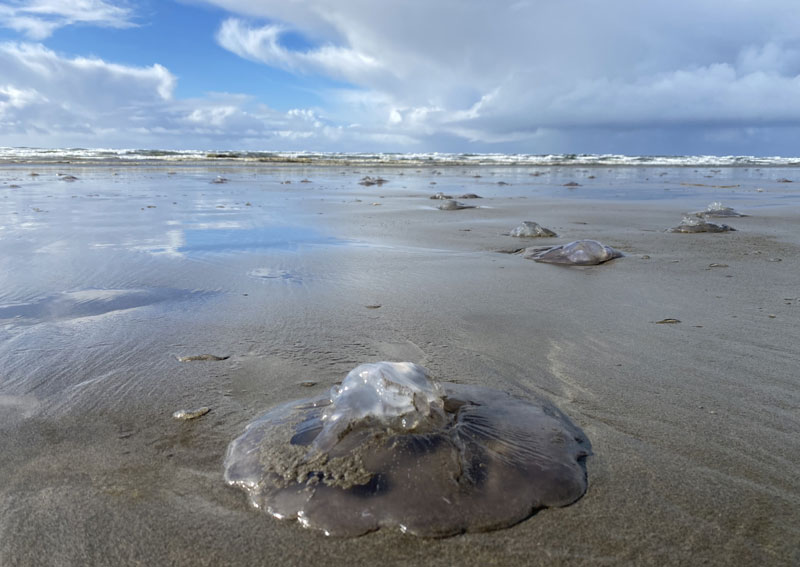Thousands of Jellies Wind Up on N. Oregon Coast
Published 02/15/22 at 5:32 PM PST
By Oregon Coast Beach Connection staff

Includes exclusive listings; some specials in winter
In Cannon Beach:
Includes rentals not listed anywhere else
In Manzanita, Wheeler, Rockaway Beach:
Some specials for winter
In Pacific City, Oceanside:
Some specials for winter
In Lincoln City:
Some specials for winter
In Depoe Bay, Gleneden Beach:
Some specials for winter
In Newport:
Look for some specials
In Waldport
Some specials for winter
In Yachats, Florence
Some specials for winter
Southern Oregon Coast Hotels / Lodgings
Reedsport to Brookings, places to stay; winter deals
(Warrenton, Oregon) – One Oregon coast group comically called it “Invasion of the Jellies!” in a faux, old-school horror movie turn-of-the-phrase. (Photos courtesy Seaside Aquarium's Tiffany Boothe)
It's no invasion, however, it's just a lot of moon jellies washing up on the north Oregon coast because that's simply what nature does every once in awhile. And it will likely be extraordinarily brief.
Tiffany Boothe of Seaside Aquarium said beaches from Gearhart, Seaside and Warrenton have received hundreds - even thousands of them - depending on the area. One expert they deal with said it was the most he'd seen in decades.
“While he was out on the beach photographing, he started to notice moon jellies washing in as the tide came in,” Boothe said. “He gave us a call because in all of his years on the beach he had never seen so many moon jellies wash in at once.”
Boothe and others from the aquarium went out to check it out and they quickly confirmed what their contact had said.
“There were hundreds if not thousands of moon jellies concentrated on the high tide line, and more were coming in,” Boothe said. “Once moon jellies hit the beach, they are no longer alive and there is no way to save them.”
A group of of moon jellies is called a smack, Boothe said. This sort of thing happens because there's simply a lot of them offshore for whatever reason, and since the moon jelly (known officially as Aurelia aurita) isn't a strong swimmer, it's at the mercy of the winds and tides. If there's a large smack of them out there, they wash ashore in large numbers.

Boothe explains it's not some anomalous environmental issue or related to climate change. It's the ocean: stuff washes up. A lot.
Boothe explains:
“Why so many? Simply ocean conditions, currents, and wind. Moon jellies cannot swim against the ocean's currents. When a large group of jellyfish gather close to shore localized surfaces winds and currents can cast them onto the beach and this is exactly what happened. A large concentration of moon jellies gathered close to shore and then the wind picked up and started snorting out of the west. This pushed the jellies onto local beaches.”
While this occurs with regularity, this inundation was unusual and of note, she said.
“It is actually part of their natural life cycle,” Boothe said. “We see them on the beach all of the time. What was interesting in this event was the concentration of them.”
It would actually be alarming if jellyfish stopped washing up.
How a lot of them start breeding off the Oregon coast is interesting as well.
“Just off the Oregon coast the ocean temperatures are influenced by the Columbia River, ocean upwellings and regional currents that bring a plethora of species along with warmer water,” Boothe said. “These factors are a recipe for huge smacks of jellies to thrive and multiply.”
Then there's one rather weird part about all this. If you want to see this, you'd better hurry.
“Once the jellies wash in, they start to dry out and within 24 hours you may never even know that a large-scale event has occurred,” Boothe said.
Oregon Coast Hotels in this area - South Coast Hotels - Where to eat - Maps - Virtual Tours
Cannon Beach Lodging
Nehalem Bay Lodgings
Manzanita Hotels, Lodging
Three Capes Lodging
Pacific City Hotels, Lodging
Lincoln City Lodging
Depoe Bay Lodging
Newport Lodging
Waldport Lodging
Yachats Lodging
Oregon Coast Vacation Rentals
Oregon Coast Lodging Specials
More About Oregon Coast hotels, lodging.....
More About Oregon Coast Restaurants, Dining.....
LATEST Related Oregon Coast Articles
Through 2 a.m. likely best, but some lights possible through dawn June 1 - 2. Space weather, astronomy
Rare Sperm Whale Stranding on N. Oregon Coast, Was Hit by Boat
Showing up near Gearhart, it will decompose naturally. Marine sciences
Coast Guard Barque 'America's Tall Ship' Coming to Portland Rose Fest, N. Ore...
Portland events: June 5 - 8; Astoria events June 13 - 15. Weather
Bright and Active Arietids Meteors May Hit Pre-Dawn Hours of Oregon, Washingt...
Look to east hour before sunrise and you may catch a show. Sciences, astronomy, weather
Why Now Could Be a Great Week for Spotting Killer Whales on Oregon Coast - Video
A good dozen documentations around Depoe Bay, Newport, Coos Bay, Bandon, Tillamook. Marine sciences
Summer Road Work, Traffic Issues Along Oregon Coast Include Astoria, Garibald...
Some daylight closures include bridges, OR 22, OR 18, OR 26, more. Travel tips. Seaside, Cannon Beach, Lincoln City. Travel tips
Pacific City Oregon Weather, 7-Day Forecasts, Live Conditions, Radar, Webcams...
Updated Constantly: Pacific City, Tierra Del Mar, Oregon Weather, Cams, Buoy Observations, Tides, Warnings - Alerts
Oregon Coast Has World's Oldest Harbor Seal, Celebrating 50 Years Soon
June 3 at Oregon Coast Aquarium in Newport. Newport events
Back to Oregon Coast
Contact Advertise on BeachConnection.net
All Content, unless otherwise attributed, copyright BeachConnection.net Unauthorized use or publication is not permitted






















































